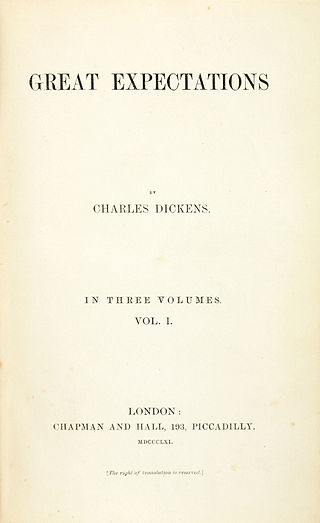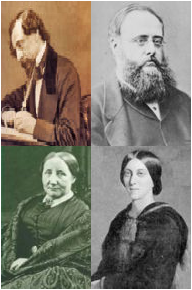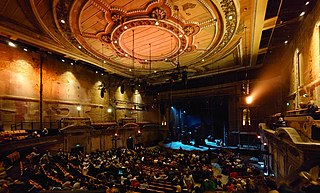
No Thoroughfare is a stage play and novel by Charles Dickens and Wilkie Collins, both released in December 1867.

No Thoroughfare is a stage play and novel by Charles Dickens and Wilkie Collins, both released in December 1867.
In 1867 Charles Dickens and Wilkie Collins collaborated to produce a stage play titled No Thoroughfare: A Drama: In Five Acts. [1] The two had previously collaborated on the play The Frozen Deep . This was the last stage production to be associated with Dickens, who died in June 1870. The play opened at the Adelphi Theatre on 26 December 1867.
The novel No Thoroughfare was also first published in 1867, in the Christmas number of Dickens's periodical All the Year Round . There are thematic parallels with other books from Dickens's mature writings, including Little Dorrit (1857) and especially Our Mutual Friend (1865).
The publication of the story in All The Year Round represents an early example of commercial merchandising, promoting the story to those who were aware of the stage play, and the play to those who had read the book. The chapters of the book are referred to as 'acts', and match the acts of the play.
In the book Collins assisted in Act 1 and Act 4; [2] Collins scripted most of the stage play with Dickens's assistance. [3]

Two boys from the Foundling Hospital are given the same name, (Walter Wilding), with disastrous consequences in adulthood. After the death of one – now a proprietor of a wine merchant's company – the executors, to right the wrong, are commissioned to find a missing heir. Their quest takes them from wine cellars in the City of London to the sunshine of the Mediterranean – across the Alps in winter. Danger and treachery would prevail were it not for the courage of the heroine, Marguerite, and a faithful company servant.
The story contains crafted descriptions, well-drawn and diverse characters, eerie and exotic backgrounds, mystery, semi-concealed identities, brinkmanship with death, romance, the eventual triumph of Good over Evil, and many other elements expected in classic Dickens.
At 48,000 words it is the length of many modern novels, and longer than any of Dickens' Christmas novels, which are all between 31,000-34,000 words.
The stage play follows a similar plotline to the novel, but is compressed and made particularly dramatic in the fourth act, which is set in the Swiss Alps. The tension builds to a spectacular scene in which Obenreizer, the villain, confronts the hero George Vendale, at the side of a mountain gorge. It has been performed rarely since the 1867 West End premiere, in 1876 at the Olympic Theatre [4] and in 1904 at a small theatre in Islington. However, on 2 June 2007 Primavera Productions produced a staged reading, directed by Tom Littler, at the King's Head Theatre in London. The reading starred Louise Brealey as Marguerite.

Charles John Huffam Dickens was an English novelist and social critic who created some of the world's best-known fictional characters, and is regarded by many as the greatest novelist of the Victorian era. His works enjoyed unprecedented popularity during his lifetime and, by the 20th century, critics and scholars had recognised him as a literary genius. His novels and short stories are widely read today.

Great Expectations is the thirteenth novel by Charles Dickens and his penultimate completed novel. It depicts the education of an orphan nicknamed Pip. It is Dickens' second novel, after David Copperfield, to be fully narrated in the first person. The novel was first published as a serial in Dickens's weekly periodical All the Year Round, from 1 December 1860 to August 1861. In October 1861, Chapman & Hall published the novel in three volumes.

William Wilkie Collins was an English novelist and playwright known especially for The Woman in White (1859), a mystery novel and early "sensation novel", and for The Moonstone (1868), which established many of the ground rules of the modern detective novel and is also perhaps the earliest clear example of the police procedural genre.

Simon Phillip Hugh Callow is an English actor. Known as a character actor on stage and screen, he has received numerous accolades including an Olivier Award and Screen Actors Guild Award as well as nominations for two BAFTA Awards. He was made a Commander of the Order of the British Empire (CBE) for his services to acting by Queen Elizabeth II in 1999.

Household Words was an English weekly magazine edited by Charles Dickens in the 1850s. It took its name from the line in Shakespeare's Henry V: "Familiar in his mouth as household words."

All the Year Round was a Victorian periodical, being a British weekly literary magazine founded and owned by Charles Dickens, published between 1859 and 1895 throughout the United Kingdom. Edited by Dickens, it was the direct successor to his previous publication Household Words, abandoned due to differences with his former publisher.

The Cricket on the Hearth: A Fairy Tale of Home is a novella by Charles Dickens, published by Bradbury and Evans, and released 20 December 1845 with illustrations by Daniel Maclise, John Leech, Richard Doyle, Clarkson Stanfield and Edwin Henry Landseer. Dickens began writing the book around 17 October 1845 and finished it by 1 December. Like all of Dickens's Christmas books, it was published in book form, not as a serial.
Simon Bucher-Jones is an author, poet, and amateur actor. He is best known for his Doctor Who novels for Virgin and BBC and as a contributor to the Faction Paradox spin-off series. Between 1988 and Dec 2018, he worked for the Home Office, in a variety of casework, admin, IT support, and planning positions. From Jan 2019 he was a freelance writer

Ellen Lawless Ternan, also known as Nelly Ternan or Nelly Wharton-Robinson, was an English actress known for association with the author Charles Dickens.
The sensation novel, also sensation fiction, was a literary genre of fiction that achieved peak popularity in Great Britain in the 1860s and 1870s. Its literary forebears included the melodramatic novels and the Newgate novels, which focused on tales woven around criminal biographies; it also drew on the Gothic, romance, as well as mass market genres. The genre's popularity was conjoined to an expanding book market and growth of a reading public, by-products of the Industrial Revolution. Whereas romance and realism had traditionally been contradictory modes of literature, they were brought together in sensation fiction. The sensation novelists commonly wrote stories that were allegorical and abstract; the abstract nature of the stories gave the authors room to explore scenarios that wrestled with the social anxieties of the Victorian era. The loss of identity is seen in many sensation fiction stories because this was a common social anxiety; in Britain, there was an increased use in record keeping and therefore people questioned the meaning and permanence of identity. The social anxiety regarding identity is reflected in novels such as The Woman in White and Lady Audley's Secret.

A Tale of Two Cities is a historical novel published in 1859 by Charles Dickens, set in London and Paris before and during the French Revolution. The novel tells the story of the French Doctor Manette, his 18-year-long imprisonment in the Bastille in Paris, and his release to live in London with his daughter Lucie whom he had never met. The story is set against the conditions that led up to the French Revolution and the Reign of Terror.

"A House to Let" is a short story by Charles Dickens, Wilkie Collins, Elizabeth Gaskell and Adelaide Anne Procter. It was originally published in 1858 in the Christmas edition of Dickens's Household Words magazine. Collins wrote the introduction and collaborated with Dickens on the second story and ending, while Gaskell and Proctor wrote the remainder.

The Frozen Deep is an 1856 play, originally staged as an amateur theatrical, written by Wilkie Collins under the substantial guidance of Charles Dickens. Dickens's hand was so prominent—beside acting in the play for several performances, he added a preface, altered lines, and attended to most of the props and sets—that the principal edition of the play is entitled "Under the Management of Charles Dickens". John C. Eckel wrote: "As usual with a play which passed into rehearsal under Dickens' auspices it came out improved. This was the case with The Frozen Deep. The changes were so numerous that the drama almost may be ascribed to Dickens". Dickens himself took the part of Richard Wardour and was stage-manager during its modest original staging in Dickens's home Tavistock House. The play, however, grew in influence through a series of outside performances, including one before Queen Victoria at the Royal Gallery of Illustration, and a three-performance run at the Manchester Free Trade Hall for the benefit of the Douglas Jerrold Fund to benefit the widow of Dickens's old friend, Douglas Jerrold. There, night after night, everyone—including, by some accounts, the carpenters and the stage-hands—was moved to tears by the play. It also brought Dickens together with Ellen Ternan, an actress he hired to play one of the parts, and for whom he would later leave his wife Catherine. The play remained unpublished until a private printing appeared sometime in 1866.
Primavera Productions is a professional theatre company founded in 2003 by Tom Littler, who is also the Artistic Director. It is based in London, UK.
The bibliography of Charles Dickens (1812–1870) includes more than a dozen major novels, many short stories, several plays, several non-fiction books, and individual essays and articles. Dickens's novels were serialized initially in weekly or monthly magazines, then reprinted in standard book formats.

A Christmas Carol, the 1843 novella by Charles Dickens (1812–1870), is one of the English author's best-known works. It is the story of Ebenezer Scrooge, a greedy miser who hates Christmas, but is transformed into a caring, kindly person through the visitations of four ghosts. The classic work has been dramatised and adapted countless times for virtually every medium and performance genre, and new versions appear regularly.
Theatre Calgary is theatre company in Calgary, Alberta, Canada, established as a professional company in 1968. The following is a chronological list of the productions that have been staged since its inception as Musicians and Actors Club (MAC) from 1964 to 1968, and Theatre Calgary from 1968 onwards.

A Christmas Carol is a one-man stage performance by English actor Patrick Stewart of the Charles Dickens 1843 novella of the same title, which has been performed in the United Kingdom and the United States on occasion since 1988.

Sarah Jane Woolgar was an English stage actress. She had leading roles in plays by notable dramatists of the day, including original productions. She had a long association with the Adelphi Theatre in London.

John Billington was an English actor, for many years a member of the company of the Adelphi Theatre in London.